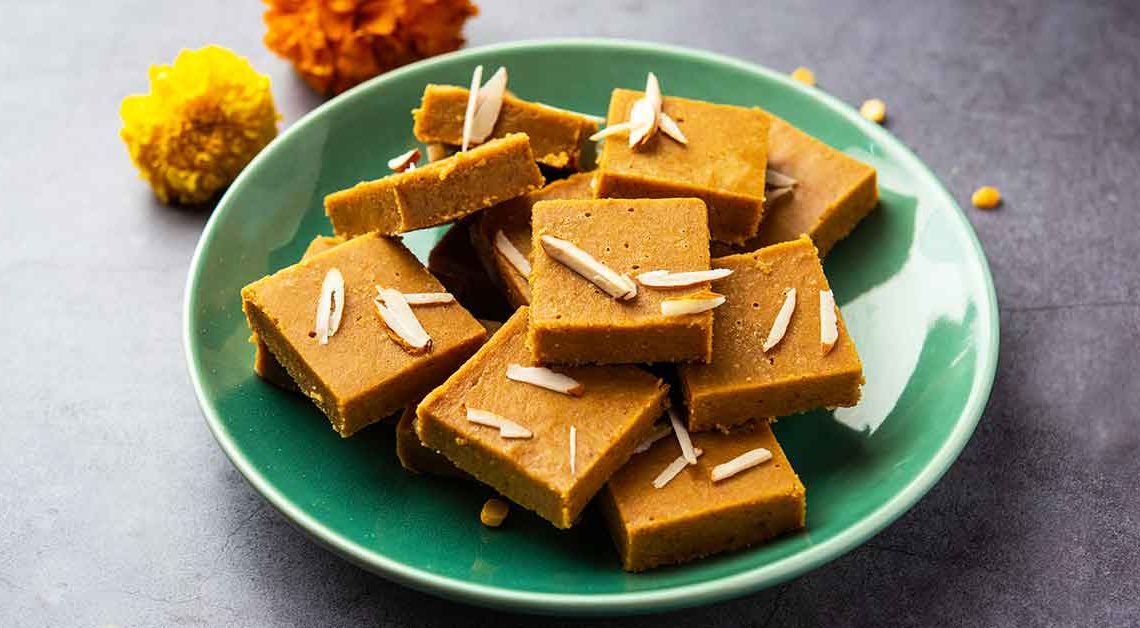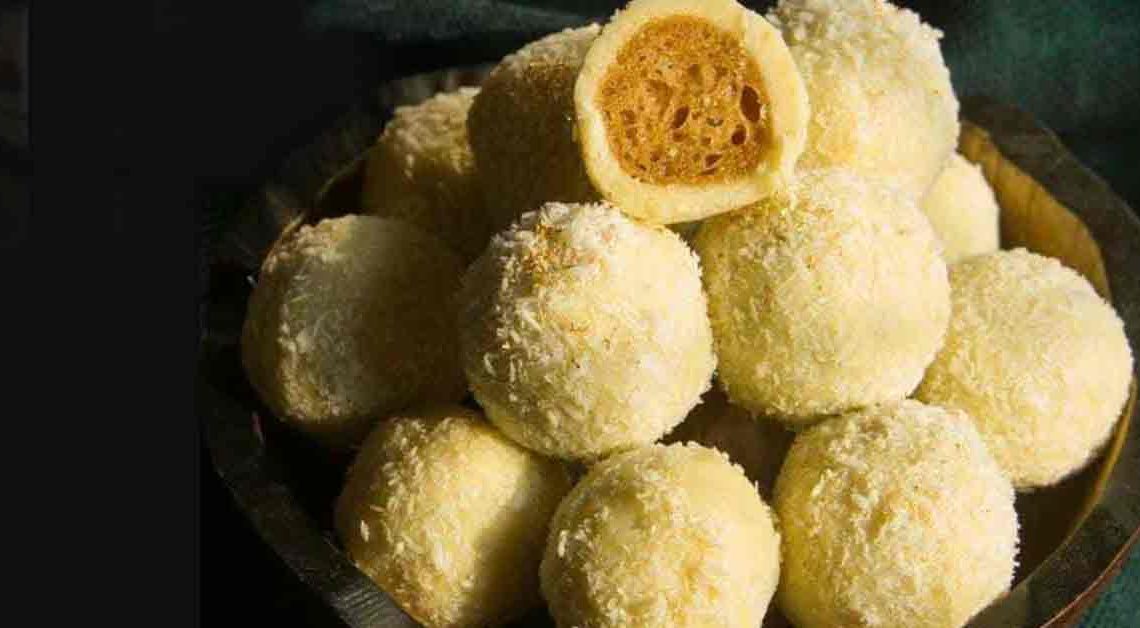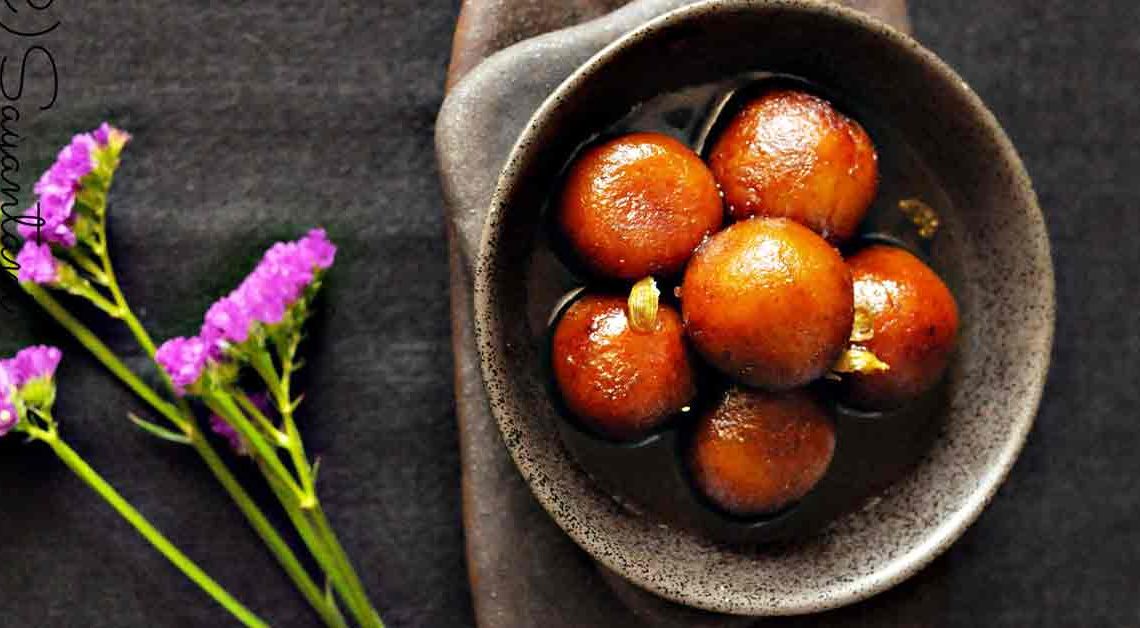The Story of Moongh Thaal: A Gujarati Delight with a Mughal Bite

Welcome to my Mithainama!!, where I share my passion for cooking and eating delicious vegetarian dishes from around the world. Today, I want to introduce you to one of my favorite Indian sweets: Moongh Thaal.
Moongh Thaal is a sweet and rich dessert made with moong dal, which is yellow split mung beans. Moong dal is a nutrient-rich food that is high in protein, fiber, folate, and vitamin B61. It is also easy to digest and has a mild flavor that can be enhanced with spices and ghee.
To make Moongh Thaal, you need to soak the moong dal for a few hours, then grind it into a fine paste. Then, you cook the paste with ghee, semolina, and besan (chickpea flour) until it turns golden brown. Next, you add sugar syrup flavored with saffron and cardamom, and cook until the dal absorbs all the liquid. Finally, you garnish the halwa with chopped nuts and khoya (milk solids).
The result is a decadent and aromatic dessert that melts in your mouth. It is perfect for special occasions like weddings, festivals, or winter nights. You can serve it hot or cold, with some chaas (buttermilk) or lassi (yogurt drink) on the side. If you are looking for a new way to enjoy moong dal, give this recipe a try.
The Origin of Moongh Thaal
Moongh Thaal originated in Gujarat, a state in western India that is known for its diverse and delicious cuisine. Gujarat has a long history of trade and commerce with various regions of the world, such as Persia, Arabia, Africa, Europe, and Southeast Asia. This has influenced the Gujarati food culture, which incorporates different ingredients, spices, and techniques.
Moongh Thaal is one of the many sweet dishes that Gujarat is famous for. Gujaratis have a sweet tooth and love to end their meals with desserts or snacks called mithai. Moongh Thaal is a variation of moong dal halwa, a common dessert made with moong dal in many parts of India. The word halwa comes from the Arabic word halwa meaning sweet confection.
Moongh Thaal is made with more ghee and sugar than the regular moong dal halwa and has a thicker consistency. It is also cooked for a longer time until it forms a soft dough-like texture that can be cut into pieces. Moongh Thaal is also known as magaj or magas in some parts of Gujarat.
The History of Moongh Thaal
The history of Moongh Thaal can be traced back to the Mughal era when the Mughals brought their culinary traditions and ingredients to India. According to one legend, moong dal halwa was invented by a cook who was asked to prepare a light and flavourful dal for Prince Murad Baksh (the third son of Shah Jahan) in 1625. The cook accidentally discovered that cooking moong dal on a slow flame can result in a dish that is slightly sweet, velvety and just as flavourful as toor dal. He served it in a bowl made of dried betel nut leaf with a garnish of amchur (dried mango powder), onions and green chillies. The prince loved the dish and named it moong dal halwa.
Another legend credits the creation of moong dal halwa to Kundan Lal Gujaral, the founder of the Moti Mahal in Delhi. He added ghee, sugar, and cardamom to the traditional moong dal preparation and created a rich and creamy dessert that became popular among his customers.
Moongh Thaal is a Gujarati adaptation of moong dal halwa. It is often prepared and consumed during religious festivals and auspicious occasions, such as Diwali, Holi, Raksha Bandhan, Janmashtami, Ganesh Chaturthi, Navratri, etc. It is also an integral part of weddings and other ceremonies, such as engagements, anniversaries, birthdays, baby showers, housewarmings, graduations, etc. Moongh Thaal is often given as a token of love, respect, appreciation, congratulations, or apology. It is also used as a prasad (an offering to God) in temples and shrines.
The Cultural Significance of Moongh Thaal
This Sweet is a symbol of celebration, joy, and prosperity in Gujarati culture. It is often prepared and consumed during religious festivals and auspicious occasions, such as Diwali, Holi, Raksha Bandhan, Janmashtami, Ganesh Chaturthi, Navratri, etc.
This sweet is also an integral part of weddings and other ceremonies, such as engagements, anniversaries, birthdays, baby showers, housewarmings, graduations, etc. Moongh Thaal is often given as a token of love, respect, appreciation, congratulations, or apology. It is also used as a prasad (an offering to God) in temples and shrines.
The sweet reflects the generosity and hospitality of Gujaratis. It showcases the richness and sweetness of their cuisine and culture. It also brings people together across religions, castes, classes, genders, ages, and backgrounds. Moongh Thaal is a sweet that everyone can enjoy and share.
Where Moongh Thaal is Famous
This Sweet is famous all over India, but some places are especially known for their Moongh Thaal. Here are some of them:
- Ahmedabad: The largest city of Gujarat and one of the fastest-growing metropolises in India is famous for its street food culture and variety of sweets. You can find Moongh Thaal in many sweet shops across the city, especially in areas with a rich history and heritage.
- Surat: The diamond city of Gujarat and one of the cleanest cities in India is famous for its unique cuisine that blends Gujarati and Parsi influences. You can find Moongh Thaal in many sweet shops across the city, especially in areas with a lively and vibrant atmosphere.
- Rajkot: The former capital of Saurashtra region and one of the prime industrial centres in Gujarat is famous for its traditional snacks and sweets. You can find Moongh Thaal in many sweet shops across the city, especially in the areas that have a busy and bustling environment.
- Vadodara: The cultural capital of Gujarat and one of the most cosmopolitan cities in India is famous for its royal heritage and artistic legacy. You can find Moongh Thaal in many sweet shops across the city, especially in areas with a modern and sophisticated lifestyle.
Facts and Trivia
Here are some interesting facts and trivia about Moongh Thaal:
- It is sometimes confused with besan barfi or besan magaj, another type of Gujarati sweet that has a similar name but a different taste and texture. Besan barfi or besan magaj is made with gram flour (besan) instead of moong dal and has a grainy texture.
- It is sometimes flavoured with saffron or rose water to give it a more exotic taste and aroma. Some people also add khoya (dried milk solids) or milk powder to make it more rich and creamy.
- It can be stored for a long time in an airtight container at room temperature or in the refrigerator. It can also be frozen for up to six months.
- It can be served hot or cold, depending on your preference. Some people like to warm it slightly before serving to enhance its flavour and texture.
- It can be cut into different shapes and sizes according to your liking. Some people like to cut it into squares or diamonds, while others like to cut it into round or triangles.
Did you know?
Moongh Thaal is not only a delicious dessert but also a nutritious one? Moongh Thaal is made with moong dal, which is rich in protein, fibre, vitamins, and minerals. Moong dal can help lower cholesterol, blood pressure, and inflammation, as well as improve digestion, metabolism, and blood sugar levels. Moongh Thaal also contains ghee, which is a form of clarified butter that has many benefits for your health, such as improving digestion, boosting immunity, enhancing skin and hair health, and supporting brain function. Ghee also contains healthy fats that can help you lose weight and balance your hormones. Sugar and cardamom add sweetness and flavour to Moongh Thaal.
Sugar provides instant energy and can improve your mood and mental alertness. Cardamom is a fragrant spice that has many medicinal properties. Cardamom can help improve digestion, fight infections, relieve cough and cold, and detoxify your body. So the next time you crave for something sweet, try Moongh Thaal and enjoy its taste and health benefits!
I hope you enjoyed reading this blog on Moongh Thaal.







